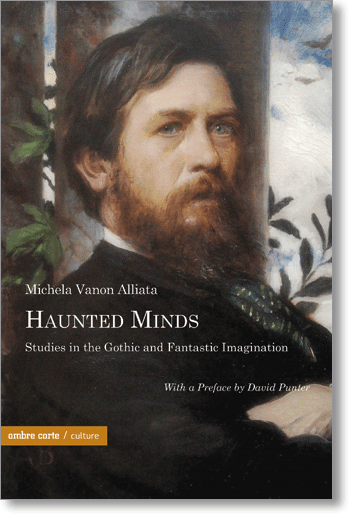 |
 |
|
|


RASSEGNA STAMPA
|
|
|
|
|
Haunted Minds
|
|
Studies in the Gothic and Fantastic Imagination
|
|
|
|
pp. 255
|
|
€ 22,00
|
|
isbn 9788869480812
|
Il libro
The introduction of the supernatural into literary discourse, together with an emphasis on insanity, visions and hallucinations, and not excluding such extreme motifs as sadism and bestiality, demonstrates how in the mid and late nineteenth-century the Gothic tradition was still a potent resource for presenting a wide-range of psychological and cultural anxieties, perhaps to some extent a reaction to Victorian evolutionary positivism, the era's optimistic confidence in science and the inevitability of progress.
Without exception, in the ghost stories and vampire tales here analysed, which belong to what has been identified as the Victorian Gothic, the concern with subjectivity and with the inner workings of the mind is so pronounced that they can be viewed as psychological haunting narratives rather than as indulging in the extravagant excesses one usually associates with Gothic.
The title of the book - which considers such significant figures as Bram Stoker, R.L. Stevenson, Henry James, Vernon Lee, and Arthur Conan Doyle among many others - is borrowed from one of Nathaniel Hawthorne's finest sketches. In The Haunted Mind he employed Gothic imagery and symbolism together with a proto-Freudian language to locate the creative process on the borderland of the unconscious. Thus, as early as 1835, in the New World, in the "land of light and affirmation", to use Leslie Fiedler's famous phrase, Gothic fiction had already defined itself as "a literature of darkness and the grotesque", a counter-narrative embracing fear, despair, and madness.
l'autrice
Michela Vanon Alliata is associate professor of English literature at the University of Ca' Foscari, Venice. She has worked on Henry James and R.L. Stevenson, as well as on the relationship between literature and the visual arts. She has written essays on various authors from Mary Shelley through Charlotte Brontë, to Conrad, Coetzee, and Atwood. She has recently edited and translated J.S. Le Fanu's Green Tea (Marsilio 2017).
iIl libro
L'introduzione del soprannaturale nel discorso letterario, unitamente all'enfasi sulla follia, sulle visioni e sulle allucinazioni, e non escludendo motivi estremi come sadismo e bestialità, dimostra come il gotico nel corso della metà e del tardo XIX secolo fosse ancora una potente risorsa per presentare un'ampia gamma di ansie psicologiche e culturali, forse in qualche misura una reazione al positivismo evolutivo vittoriano, la fiducia ottimistica dell'epoca nella scienza e l'inevitabilità del progresso.
Il titolo del libro, che include alcuni maestri del gotico e del fantastico, Bram Stoker, R.L. Stevenson, Henry James, Vernon Lee e Arthur Conan Doyle, richiama il concetto chiave di persecuzione e ossessione, ed è tratto da un breve scritto di Nathaniel Hawthorne. Nello sketch The Haunted Mind, con metafore e simboli desunti dall'immaginario gotico e un linguaggio che sembra anticipare le conquiste della ricerca freudiana, Hawthorne individuava nell'inconscio, nei recessi più bui della psiche l'origine dell'attività creativa. Così nel 1835, nel Nuovo Mondo, nel "paese della luce e dell'affermazione", per citare le celebri parole del critico americano Leslie Fiedler, il gotico si era già affermato come "una letteratura del grottesco e delle tenebre", un genere letterario capace di esprimere la paura, la disperazione e la follia.
l'autrice
Michela Vanon Alliata insegna letteratura inglese all'Università Ca'Foscari di Venezia. Studiosa dell'Ottocento, e in particolare di Henry James e R.L. Stevenson, dei rapporti fra arti figurative e letteratura, al gotico e al fantastico ha dedicato numerosi lavori fra cui l'edizione critica di Tè verde di J.S. Le Fanu (Marsilio, 2017).
|
|

|
|
 |
 |
Tutti i diritti riservati. Copyright © 2005 ombre corte edizioni
Via Alessandro Poerio, 9
- 37124 Verona
- Tel. e Fax 045 8301735
|
|  |
 |